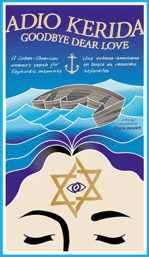 Produced and Directed by Ruth Behar
Produced and Directed by Ruth Behar
Adio Kerida is a personal documentary about the search for identity and history among Sephardic Jews with roots in Cuba. The title is borrowed from a Sephardic love song in order to highlight the themes of expulsion, departure, and exile that are at the crux of the Sephardic legacy. At the same time, the title invokes the creative energy that is injected into a culture when it crosses racial, ethnic, and national lines. It also has a personal dimension and references the desire for reconciliation between the filmmaker and her Sephardic father.
Intimate interviews with Sephardic Jews in Cuba and Cuban Miami, as well as family stories, are meshed with probing footage of dilapidated Jewish cemeteries and new Judaic rituals in Cuba to create a filmic memoir that offers a uniquely poetic and humanistic anthropological vision.
Adio Kerida begins with the Cuban-born filmmaker’s own search for memory in Cuba. Having left as a child, she cannot remember Cuba. So she returns over and over to the island to see what she can learn about herself and “her people” in the Cuba of today. She discovers that the one thousand Jews remaining on the island, almost all of them Sephardic, are constantly being observed, photographed, filmed, and given charity by Jewish tourists from the United States who have recently discovered the exotic tribe of “Castro’s Jews” and want to see them in action before they disappear.
As a Cuban Sephardic Jew herself, the filmmaker refrains from treating the Jews on the island as a sad group of castaways and delves deeply into the way the members of the Sephardic Jewish community in Cuba bring meaning, joy, song, and laughter to their everyday lives. While the filmmaker’s story informs her journey, it never overpowers the stories of her protagonists, each of whom is seen as an individual with his or her compelling quest to create an identity out of the mixture of Cuban and Sephardic cultural elements.
Conversion, intermarriage, and cultural mixing, or mestizaje, are recurrent themes in the stories. The cinematography and the narrative are juxtaposed with music that transcends the history being told with Afro-Cuban drumming, Jewish liturgical music, Sephardic love songs, tangos, boleros, oud solos, flamenco, Cuban salsa, and American jazz. The diverse range of forms embraced by Cuban Sephardim becomes a vivid presence in the documentary. Song, music, and dance emerge as a vital necessity in the lives of the Sephardic Jews of Cuba.
In Cuba, we hear the voices of Afro-Cuban children who affirm their Sephardic heritage, adult men and women who were hidden Jews and have returned to their faith through conversion, and elderly Jews who celebrate Che Guevara’s legacy, sing tango songs and love songs, and explore the fine line between forgetting and remembering.
In Miami, we hear from sellers of good luck charms, a gay hairdresser who celebrates the marriage of his Cuban Sephardic mother and Cuban Catholic father, a belly-dancer who merges flamenco, Afro-Cuban, and Turkish traditions, and the aging former rabbi of the Sephardic community of Havana.
And at the end of the journey, the video daringly explores the life of the filmmaker herself as she returns home. We follow her as she learns family secrets from her Sephardic relatives in Miami, then moves on to an encounter with her Sephardic father, who distrusts her motives in making the film, and finally see her interacting with her brother, a jazz musician who questions the purpose of anthropology and her hunger to travel to other places.
Issues of diversity and multiculturalism are presented through an examination of Jewish identity as it merges with Cuban and Latino identity. Stereotypes and mainstream images of both Jews and Latinos are challenged by showing that Jews can be Latinos and Latinos can be Jews.
Sephardic Jews view themselves as Hispanic people who are connected to both the Arab and African worlds because of their history of cultural and emotional interpenetration with those worlds. They descend from the Jewish populations expelled by the Spanish Inquisition in the fifteenth century. “Sepharad” means Spain in Hebrew.
Sephardic Jews are notable for having clung with a passion to their nostalgia for Spain and their love for the Spanish language, despite having been forced to leave Spain because of their ethnic and religious identity. They are misunderstood and often discriminated against by the mainstream Eastern European Jewish world, which can only imagine Jewish identity in terms of the novels of Philip Roth and the movies of Woody Allen.
Beyond the Jewish world, Sephardic Jews are virtually unknown as a community and they are almost invisible in the contemporary world of literature and the arts. The Cuban Sephardic community, both on and off the island, offers so rare a mix of cultural traditions–Spanish, Turkish, African, Jewish, Cuban, and American–that it remains a mystery and has not yet been portrayed in any depth in literature, art, or film.
Adio Kerida is a story of continuing diasporas and intercultural adaptations. Thus, when the filmmaker’s mother blissfully digs her teeth into a mango synonymous with the flavor and the scent of a Cuba she left behind, we are reminded of Proust’s madeleine, and led to reflect on the search for a lost time that continues to leave its mark on the fleeting moments of the present.